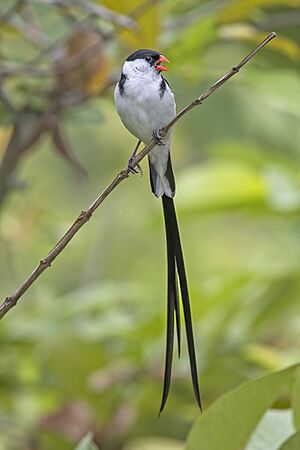Pin-tailed whydah facts for kids
Quick facts for kids Pin-tailed whydah |
|
|---|---|
 |
|
| male in breeding plumage São Tomé and Príncipe |
|
| Conservation status | |
| Scientific classification | |
| Genus: |
Vidua
|
| Species: |
macroura
|
| Synonyms | |
|
|
The pin-tailed whydah (Vidua macroura) is a small songbird known for its very long, ribbon-like tail on breeding males. This eye-catching bird lives and breeds in most parts of Africa south of the Sahara Desert. It's a resident bird, meaning it doesn't usually migrate far from its home.
Contents
About the Pin-tailed Whydah
The pin-tailed whydah was first described by a German scientist named Peter Simon Pallas in 1764. He gave it the scientific name Fringilla macroura.
What They Look Like
The pin-tailed whydah is about 12–13 cm (5 inches) long. However, the male's amazing tail can add another 20 cm (8 inches) to its length during breeding season!
Male Whydahs
- Breeding Male: During breeding season, the male has a black back and a black cap on its head. Its very long tail is also black. Its wings are dark brown with white patches. The rest of its body, including its face, is white. It has a bright red beak.
- Non-breeding Male: When it's not breeding season, the male looks more like the female. It has streaky brown feathers on its back and white feathers underneath. Its face has a buff and black pattern. It still has a red beak, but its long tail feathers are gone.
Female Whydahs
Female pin-tailed whydahs have streaky brown feathers on their upper parts. Their undersides are whitish with buff-colored flanks. Their face has a buff and black pattern. They do not have the long tail feathers that the breeding males do. Females also have a red beak.
Young Whydahs
Young pin-tailed whydahs look similar to the females. They are a bit plainer in color and have a grayish beak instead of a red one.
Where Pin-tailed Whydahs Live
You can find pin-tailed whydahs in many parts of Africa, south of the Sahara Desert. They love living in grasslands, bushy areas, and savannas. You can also spot them in parks and gardens, even in cities!
These birds have also been introduced to other places around the world. There's a good-sized group of them in southern California. They can also be found in Puerto Rico and Singapore. Sometimes, pet whydahs escape or are released, leading to small groups living in other areas too.
Life and Habits
The pin-tailed whydah has some very interesting habits, especially when it comes to raising its young.
Brood Parasites
Pin-tailed whydahs are known as "brood parasites." This means they lay their eggs in the nests of other bird species, especially small finches called waxbills. They don't build their own nests.
Unlike some other brood parasites, the whydah does not destroy the host bird's eggs. Instead, they usually add 2 to 4 of their own eggs to the host's nest. Both the whydah's eggs and the host's eggs are white, but the whydah's eggs are a little bigger. When the baby whydahs hatch, they even look like the host species' chicks inside their mouths! This helps the host parents feed them without noticing the difference.
Reproduction and Courtship
Male pin-tailed whydahs are very territorial. This means they protect their own small area. One male often has several females in his group.
The male performs a special dance to attract females. He flies in an elaborate way, hovering over the female to show off his long tail feathers. He also sings from a high spot, making fast squeaking and churring sounds.
What They Eat
Pin-tailed whydahs mainly eat seeds and grains. They forage for their food in the grassy areas where they live.
Gallery
-
male in breeding plumage
Londolozi Private Game Reserve, South Africa -
male in non-breeding plumage
Lake Bunyonyi, Uganda -
female
Lake Bunyonyi, Uganda -
male displaying to female, São Tomé and Príncipe







